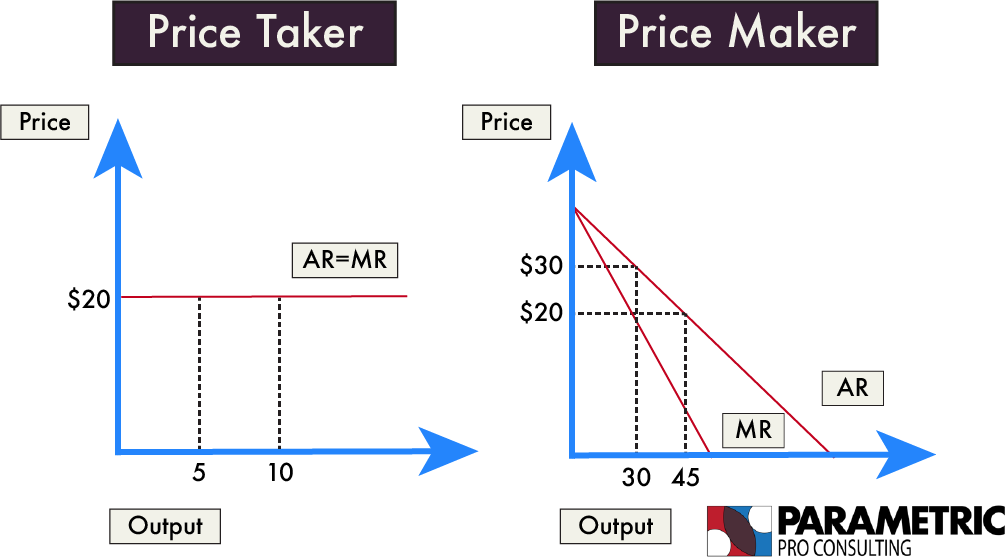How are market prices determined and set? Who has the power to influence and set market prices? What is the difference between perfect and imperfect competition? How can economics be used to better understand the market? Let's explore these ideas through the economics revenue theory using price takers and price makers.
What is a price taker?
Companies that have no control over the price their products are set at are called price takers. Price takers have a low percentage market share, meaning they have no pricing power in the market. Examples of this are miners and oil & gas companies. Generally speaking, all iron ore is the same, and the price is set by supply and demand in the market.
The demand curve will be perfectly elastic because they’re selling perfect substitutes to other suppliers. Prices will be high when supply is low and demand is low, and vice versa.
It’s important to note that just because a company doesn't have any influence over the pricing of its products, doesn't mean they are powerless when it comes to influencing profits. Revenue is a product of both price and sale volumes.
What is a price maker?
Price makers are companies that have some degree of market power to set their prices for the products and services they bring to market. Price makers are found in any imperfectly competitive market structure. Price maker examples include businesses like consumer goods manufacturers, pharmaceutical companies and technology groups. They set prices based on elasticity for that market, so the more inelastic the demand for a product, the more a company can set the price. Hypothetically price makers should be able to increase or decrease product prices without losing sales.
Economics
The key difference between the two, is that price takers accept the ruling market price, and sell each unit at that same price so AR (accounts receivable) equals MR (marginal revenue). Price makers have pricing power, and will face a downward sloping AR curve, MR will be below AR.

Perfect vs Imperfect Competition
Perfect competition does not typically exist in the real world market, because it’s a theoretical construct based on assumptions. Perfect competition is a competitive market that has numerous sellers selling equivalent products or services to numerous customers. With perfect competition, there are many buyers and sellers, and the products that are being offered are identical. Firms can come and go as they please, and the price is determined through market supply and demand.
Farmers' markets are a great example of perfect competition, generally, there will be several fruit stands. At these markets, you will find the same product for the same price, regardless of the stand. The same strawberries that one person may be selling for $10 a basket, will be the same strawberries another person is selling for $10 at another stand. Firms operating in perfect competition are considered to be price takers.
Imperfect competition has a more practical approach, it's an economic structure which does not fulfill the perfect competition conditions. Firms under this type of competition have a strong influence on the price of their products, intending to repeatedly maximize revenue. Imperfect competition is considered real-world competition and can be seen in almost every industry. Firms that operate in imperfectly competitive markets are called price makers. Let's go over the different forms of imperfect competition.
Monopolistic competition
Monopolistic competition is a type of imperfect competition which occurs when an industry has many companies offering products that are similar but not identical. By making consumers aware of product differences, sellers exert some control over price.
Oligopoly competition
This is when a few sellers supply a considerable amount of products in the market. They have some influence over the pricing of their products, however, because their products are similar, they are almost forced to follow suit if one company lowers their prices.
Monopoly
In a monopoly, there is a single seller that dominates the market. This doesn't necessarily mean globally, as a market could be a geographical area. The single seller has complete control over their product prices.
Conclusion
To summarize, a price maker is the opposite of a price taker. Price takers can’t set their own prices, and must sell each unit at the same market price. Perfectly competitive markets are where you will find price takers. Price makers have a large influence on the market price and can control the prices at which their products are sold. Price makers operate in imperfectly competitive markets, it's usually big established companies or monopolies that will be placed in this group, as they have an extreme influence on the market.